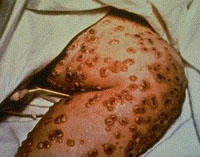
Introduction to Immunology Tutorial
History of Vaccinations
The story of smallpox
The Chinese are credited with making the observation that deliberately infecting people with mild forms of smallpox could prevent infection with more deadly forms and provide life long protection. Knowledge of the technique, known as variolation, worked its way west to Turkey by the 18th century. Lady Mary Wortley Montagu, the wife of the British Ambassador to Turkey and who had once survived smallpox, had her children treated and brought the ideas back to Britain, where research began on how to reduce the inoculation's sometimes-awful side effects. In 1798, the British physician Edward Jenner published his long-term observation that cowpox exposure protected milkmaids from smallpox. To see if this protection could be artificially induced, he exposed a "healthy boy" to cowpox virus from a milkmaid, and then attempted to infect the boy with smallpox. (Obviously, this experimental method is unethical by today's standards.) This method works because cowpox shares antigens with smallpox, but doesn't cause the disease.
Fortunately, the vaccine worked. The boy had developed an immunity to smallpox from his exposure to cowpox. The technique of vaccination against smallpox quickly spread through the world. In 1980, the World Health Assembly officially declared "the world and its peoples" free from endemic smallpox.
|
The University of Arizona
Thursday, January 15, 1998
Contact the Development Team
http://www.biology.arizona.edu
All contents copyright © 1997-2000. All rights reserved.





